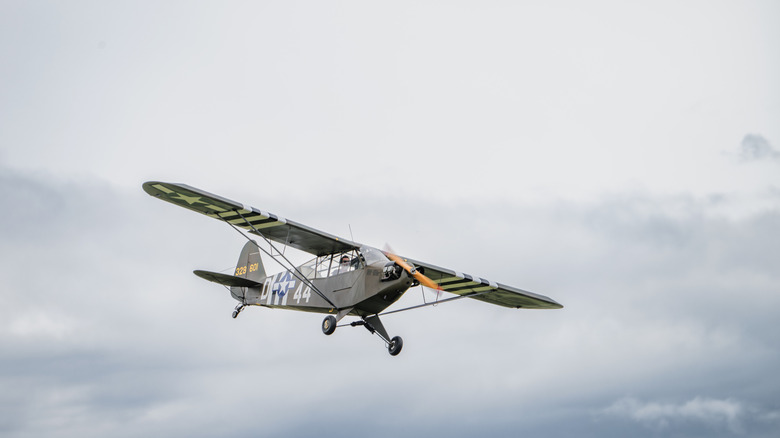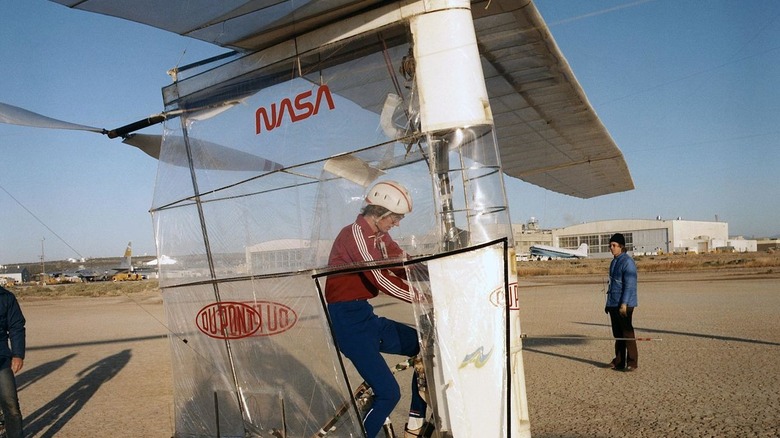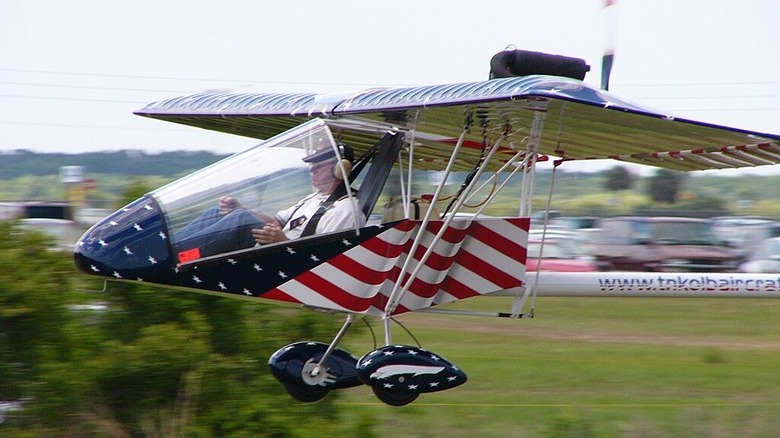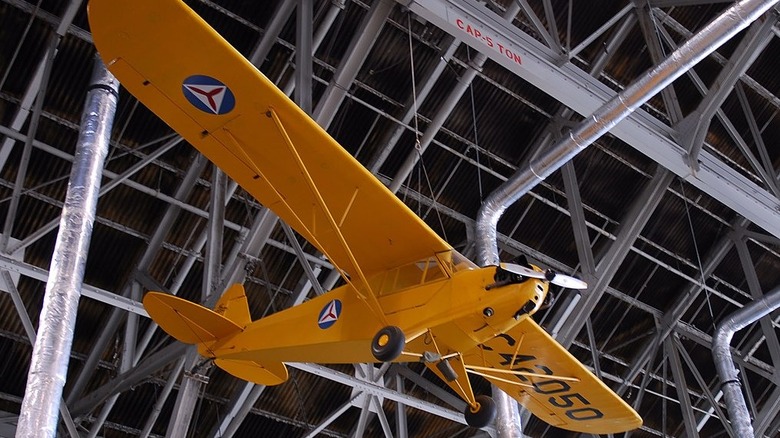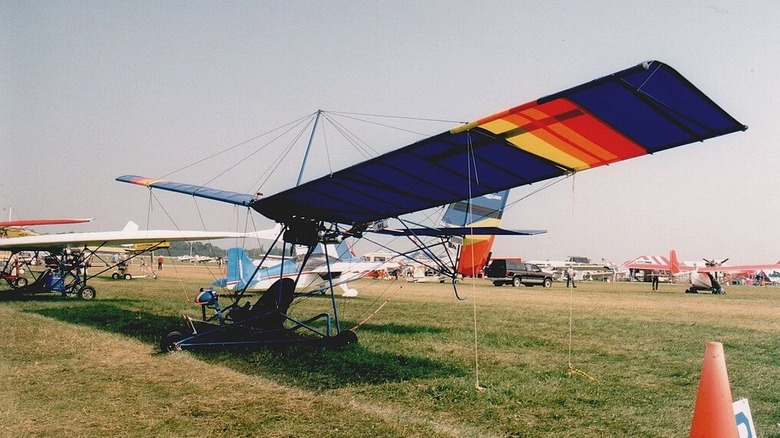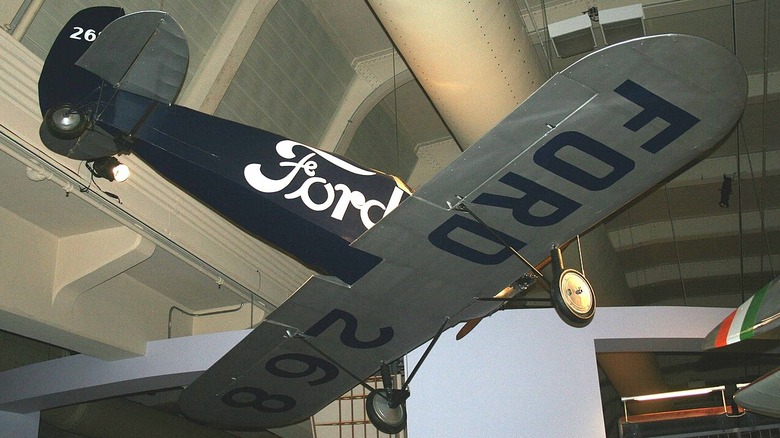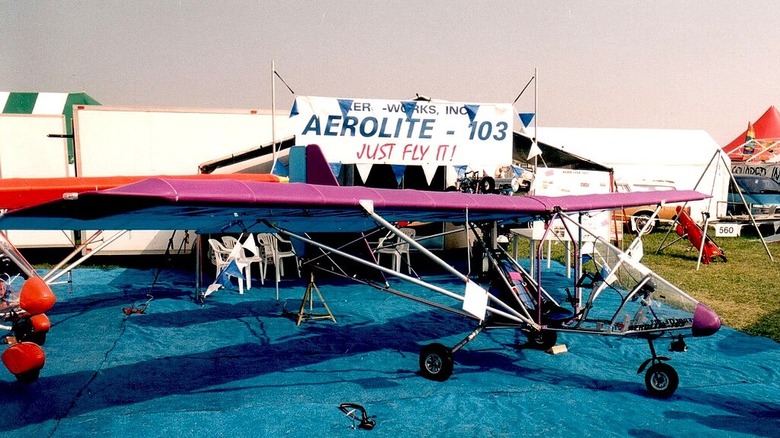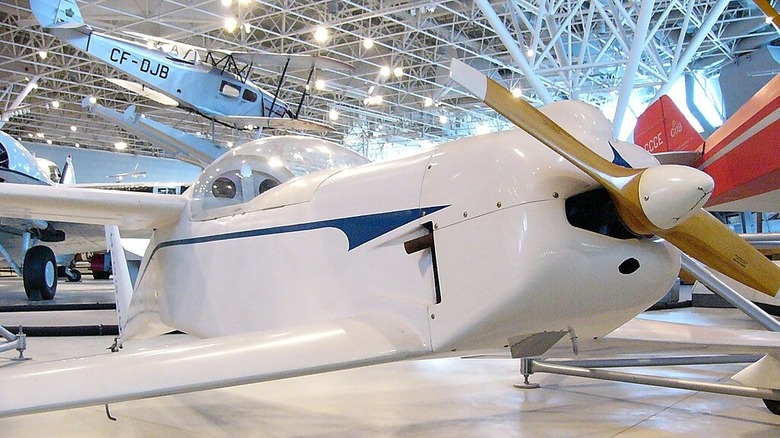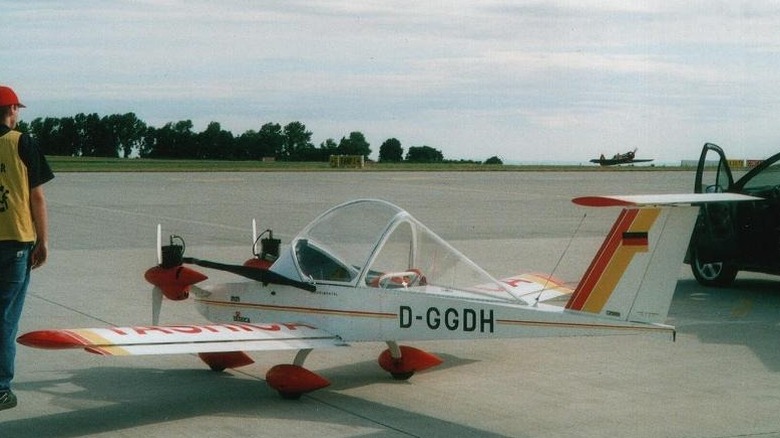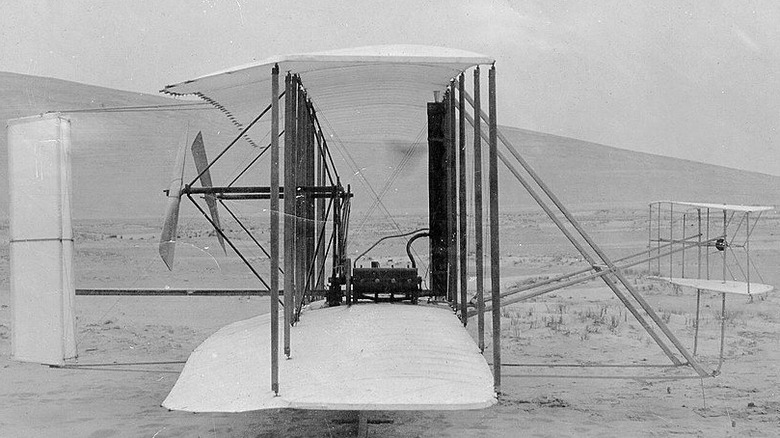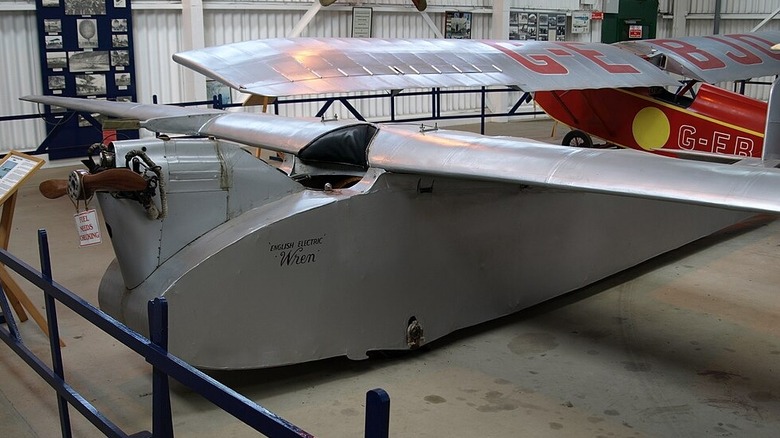10 Airplanes That Managed To Fly With Staggeringly Low Horsepower
One of the most powerful military aircraft ever built achieved 60,000 horsepower, but aviation had to start somewhere. As mind-blowing as tens of thousands of horsepower sounds, can you imagine a plane flying with under 10 HP? It turns out there are some airplanes that managed to fly despite staggeringly low horsepower, although not all of them made it into the history books.
For perspective, consider that a typical ride-on lawnmower has around 20 horsepower, depending on the model. Some airplanes have less than that, and some slightly more, which is still a very low amount of power when it comes to getting a winged craft off the ground. Remember, horsepower is a measure of power, defined as how much energy is transferred in a specific period. Quite a bit of energy is needed to get most planes off the ground, let alone maintain airspeeds high enough that they don't drop out of the sky.
While maintaining speed is no problem for a plane like the Antonov An-22 Antei (that 60,000-horsepower military aircraft), the following aircraft are shockingly agile for how little horsepower they possess.
Gossamer Albatross
In terms of horsepower, you probably can't get much lower than the power a single human can generate, which makes the Gossamer Albatross an honorable mention. Sure, it didn't have an engine, but it did accomplish takeoff speeds of up to 15 MPH and flew across the English Channel. The nearly three-hour flight spanned 22.5 miles and was entirely powered by pilot Bryan Allen, who pedaled the wood-and-carbon plane.
Although there's no official data on the Albatross for its horsepower ranking, the earlier yet similar Gossamer Condor is cited as reaching 0.33 horsepower. Thus, we can assume the Albatross reached something similar through the pilot's pedaling. Although the Albatross didn't necessarily catch on in aviation, it was a prize-winning aircraft. Not only that, but early planes like the Albatross paved the way for larger and better planes over the years, even if many still have hardly any horsepower to speak of.
Kolb Firefly
A more modern aircraft that you can still buy today, the Kolb Firefly is an ultralight plane that takes a strikingly low amount of horsepower to propel. The plane also clocks in at only 254 pounds when empty, and about 500 pounds when fully loaded. This slight aircraft has 40 horsepower, a level of power you could theoretically reach with two lawnmower engines (though we're not recommending you add wings to your lawnmower).
Despite the low horsepower, Kolb promises that the engine propels the plane effortlessly, reaching top speeds of 63 MPH. For takeoff, the plane is said to have a rate of climb of 750 feet per minute, which is a low figure compared to much more powerful planes. However, for a lightweight plane you can essentially build in your garage, there's not much to complain about with the Kolb kit.
One potential drawback of the Firefly, however, is also one of its perks. The fact that it comes in a kit might be daunting for some, but you can own one of these planes for around the same cost as a car. Would-be pilots need to pay around $20,000 for the complete kit, then assemble the aircraft themselves.
Piper J-3 Cub
One of the most popular single-engine planes, the Piper J-3 Cub originally produced 40 horsepower. While there's a lot to consider before buying a plane, the Piper J-3 Cub's price tag might have made the decision easy for passionate pilots. At the time, the Cub cost about half of what a house did, but that was only around $1,000.
After it came out in 1937, the J-3 Cub quickly became a favorite training plane, and by 1939, Piper was manufacturing one every 20 minutes — a figure that later jumped to one every 10 minutes to meet demand. Why such high demand? Not only were J-3 Cubs popular for trainees, but they were also among the various planes used by the military for operations like observation and air ambulances. In fact, the military purchased over 5,600 Grasshoppers, modified J-3 Cubs with olive green paint and few bells and whistles.
The J-3 Cub was small yet nimble, and its 40 horsepower wasn't a problem in most operations. Yet, it's scary to think that so many pilots were tasked with navigating enemy airspace in such a small, low-powered plane. In contrast, Piper's fastest plane, the M700 Fury, achieves 700 horsepower.
Eipper Quicksilver
In the early days of ultralight airplane manufacturing, the Eipper Quicksilver had some pretty impressive specs. The original Eipper Quicksilver offered 35 horsepower, and although modern ultralights have much more power, it was plenty to get the plane off the ground. That's not to say the flight experience was exactly magical, though.
Photos show that the Eipper Quicksilver's cockpit was anything but. The pilot's seat wasn't actually in a cockpit, but instead was open to the air. Compared to the J-3 Cub, the Quicksilver hardly resembled a plane in terms of design. It also couldn't travel any faster than 52 MPH, with a cruise speed of 40 MPH. Yet the aircraft offered a padded seat for "long flights," which came in handy when Peter Burgher decided to go for what was planned as a seven-day flight.
Burgher actually flew from Michigan to Florida in a record-breaking five and a half days. After that, he retired his plane, which had been modified specifically for the flight. You can no longer buy an Eipper Quicksilver as it used to be, including the original 35-horsepower engine, but you can visit the Quicksilver MX-1 at the EAA Aviation Museum in Wisconsin.
Ford Flivver
In 1926, an aeronautical engineer designed an airplane that would fit inside Henry Ford's office. The very small Ford Flivver met Ford's expectations size-wise, and its 35-horsepower engine powered many flights, both long and short, before the aircraft was retired. Henry Ford appointed Harry Brooks, who had become a Ford employee after impressing him with his flying skills, as the test pilot for the Flivver, after which Brooks flew the plane around the Ford campus. He also took the Flivver on longer trips, including a successful flight from Michigan to Florida.
Unfortunately, Harry Brooks passed away during a later long-distance flight attempt. The crash was blamed on engine trouble, and Brooks was never recovered from the wreckage. Originally, Ford had hoped to make flight affordable for the everyday person with the Flivver. However, the project eventually stalled before hitting the manufacturing line because of how deeply Brooks' death affected Ford.
After Brooks' last flight, the Flivver was retired, with the prototype placed in a museum. Despite efforts to replicate the Flivver years later, no working plane was ever manufactured. Ford, for one thing, had nothing to do with the revival. The failed replica was eventually made into a static display and, like the original, was housed in a museum.
Aerolite 103
Another kit ultralight airplane with staggeringly low horsepower is the Aerolite 103. With as little as 28 HP from a Hirth F33 engine, an Aerolite 103 can apparently manage a maximum speed of 63 MPH. However, you might not want to push the plane to its top speed, as it's a single-seat build with not much in the way of a cockpit.
Another option for pilots who want to test out low-horsepower planes for themselves, the Aerolite 103 kit gives you the option to DIY. But if you want a fully assembled airplane, that'll cost you around $30,000 — 28 HP engine included. Looking at it, the plane doesn't seem very small. The Aerolite 103 weighs about 235 pounds empty, but it has a wingspan of almost 27 feet.
If you have any reservations about flying this homemade aircraft beyond its engine power, those worries might be unfounded. The Aerolite 103 was designed in 1996 and eventually earned multiple design awards for being both lightweight and rugged. It's still produced today, so if you have the cash and storage space, you can test out the limits of its horsepower rating yourself.
Rutan Quickie
Inspired by other homebuilt airplanes, the designers of the Rutan Quickie were trying to stick to a budget while making the flight experience fun. The result was the 22-horsepower Quickie, a kit aircraft that wound up winning design awards. Though dated these days, the original Quickie was manufactured in the late 1970s with a single engine and single seat.
Although it's lightweight like similar planes, the Quickie has a fully enclosed cockpit, something not typical for lower-horsepower planes, especially home builds. Yet horsepower concerns did lead to design changes in the Quickie. At first, the plane was manufactured with a 22-horsepower engine, landing it a spot on our list. Builders reportedly found that the motor wasn't strong enough for the plane, which led to the development of a 64 HP version and, later, an 85-horsepower option.
Based on descriptions of the early Quickie's build, it did fly with the 22-horsepower engine. At a weight of 246 pounds empty, the plane was around the same weight as other home builds like the Kolb Firefly and Aerolite 103, but with far lower horsepower. This might be one airplane you're happy to know is now housed in a museum.
Colomban Cri-Cri
The Colomban Cri-Cri was recognized as the smallest twin-engined crewed aircraft in the world, and like others on this list, it also started out as a home build. In the early 1970s, an aeronautical engineer named Michel Colomban designed the plane, naming it after his daughter Christine.
The Cri-Cri used two 15-horsepower engines, which doesn't sound like much to propel a 375-pound aircraft at maximum takeoff weight. The plane had a range of 310 miles and, by all accounts, was a great build. Its rate of climb was 850 feet per minute, faster than similar, higher-horsepower planes like the Kolb Firefly. The difference was that the Cri-Cri was made of aluminum, while many other home builds were not. It also had an enclosed cockpit, which wasn't a given in every ultralight airplane design.
While the Colomban Cri-Cri was sold in kits around the world and was apparently successful, it didn't last. Production eventually stopped due to an abundance of crashes. Apparently, the company faced lawsuits over the incidents. Those lawsuits led to the plans no longer being available (and builders no longer being supported) in North America, although builders say they are still available elsewhere in the world.
Wright Flyer
Back when the Wright brothers began designing their first-ever airplane, they had some pretty low horsepower requirements. In fact, their design called for 8 horsepower, according to the National Air and Space Museum, but the brothers ultimately designed a 12-horsepower motor. The motor was specifically built for flight and lacked many standard features of an engine, like a carburetor and spark plugs.
However, the Wright Flyer successfully flew, building on the Wright brothers' previous development of three gliders. The plane's first flight lasted only 12 seconds, covering 120 feet, but subsequent flights reached 59 seconds and 852 feet.
Unsurprisingly, the 605-pound plane couldn't reach very high altitudes with a 12-horsepower engine, but at the time, it was surprising that the craft got off the ground at all. Built with wood, muslin, and aluminum on the engine crankcase, the plane doesn't resemble modern planes much. These days, we rely on far more horsepower for flight, but the Wright Flyer I remains one of the most iconic airplanes in history, despite its staggeringly low horsepower.
English Electric Wren
Would you believe that an airplane could get off the ground with only 3 horsepower? It turns out that it happened in the 1920s with the English Electric Wren. The plane, designed by the English Electric Company, purposely used as little power as possible. Unlike other planes, though, the English Electric Wren didn't have very lofty goals to achieve. Rather, the designers wanted to create a training aircraft that could fly for 30 minutes.
The lightweight design was also important, so the plane was built with a wooden fuselage and fabric covering. Its 3-horsepower engine was taken from a motorcycle and adapted for use in an airplane. While you might not expect much from such an aircraft, the Wren successfully flew to a height of 2,350 feet and reached a maximum speed of 52 MPH. One iteration of the Wren even traveled 87.5 miles on a single gallon of fuel.
Despite all the publicity, the English Electric Wren was never put into production; it's thought that only three were ever made. In the 1950s, an original Wren was restored to flight, but eventually wound up in a museum anyway. The Wren sometimes still flies, but its 3-horsepower engine doesn't offer as much juice as it used to.
